November 9th, 2019
BURLINGTON, ON
During the past two week our political columnist Ray Rivers has written about the way we elect our federal politicians.
The current system is called First Past The Post (FPTP) It’s pretty simple, the political party that wins the most seats gets to form the government. If no one political party has 50% of the seats in the House of Commons they do get a chance to meet and see if they can create a majority with the support of a different political party.
You know when they don’t have the support from another political party when there is a confidence vote. These are votes that have to do with money bills – the budget being the biggest one.
When the government cannot get the confidence of the House – the government falls and under normal circumstances an election takes place.
The Governor General can ask another political party to see if they can form a government. In theory at least.
Dave Meslin, the author of Teardown: Rebuilding Democracy from the Ground Up believes that Canada has it all wrong – he believes there is a way to elect Members of Parliament that allows everyone to be fairly represented based on the number of seats won. He has put together an informative series of graphics.
Here’s how Canadians actually voted at the ballot box:
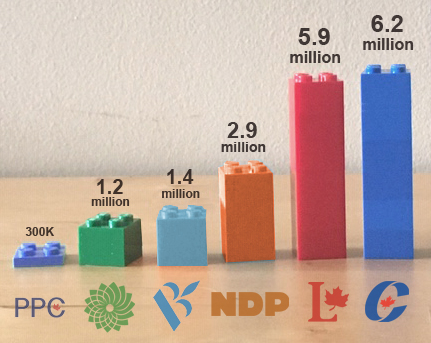 And here’s how that same chart looks, if we add all the registered voters who decided to NOT participate at all.
And here’s how that same chart looks, if we add all the registered voters who decided to NOT participate at all.
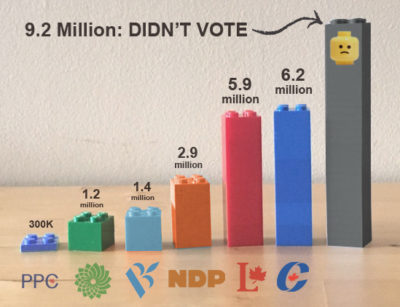 One third of all registered voters decided not to vote. Canada’s ridiculous voting system gives us a lot of reasons to not participate:
One third of all registered voters decided not to vote. Canada’s ridiculous voting system gives us a lot of reasons to not participate:
Dozens of “safe seats” that never change.
Hundreds of candidates who “win” with less than 50% of the vote.
Endless chatter about “strategic voting” and “vote splitting”
Fake majority governments, that don’t actually represent a majority of voters.
Hostile and polarized election campaigns.
Larger parties getting more seats than they actually earned.
Smaller parties getting less seats than they actually earned.
Here are the seats “won” by each major party in Canada, on October 21:
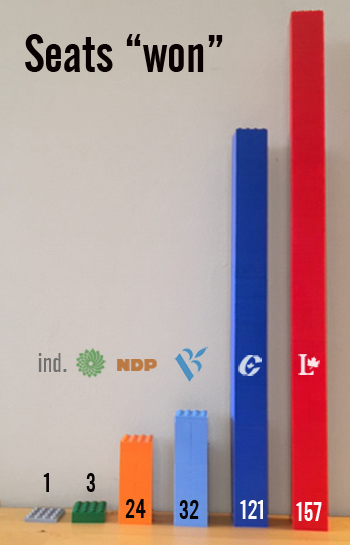 If you compare that to the ACTUAL vote we saw at the top of the page, you’ll notice a few major differences. First, the conservatives got more votes than the Liberals… but less seats.
If you compare that to the ACTUAL vote we saw at the top of the page, you’ll notice a few major differences. First, the conservatives got more votes than the Liberals… but less seats.
That’s backwards.
Same goes for the Bloc Quebecois and the New Democratic Party.
The NDP got WAY more votes than the Bloc… but far less seats. Again, totally backwards.
And the Green Party, who earned almost as many votes as the Bloc, only won three seats – compared to the Bloc’s 32.
Lastly, the People’s Party didn’t win a single seat, despite having the support of hundreds of thousands of Canadians.
Proportionally, this is what Canada’s parliament should look like:
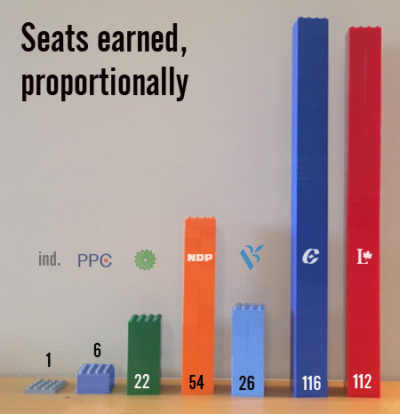 As you can see, the Conservative party would have the most seats – since they got the most votes! Of course, that doesn’t mean that they would be able to form a government.
As you can see, the Conservative party would have the most seats – since they got the most votes! Of course, that doesn’t mean that they would be able to form a government.
In Canada’s parliamentary system, a party needs to gain “confidence of the House”, meaning that they either need to win a majority of the seats or find another party to support them in the House of Commons.
With 116 seats, the Conservatives are nowhere close to a majority:
In fact, the Conservatives would have a very difficult time forming a government based on the proportional results of this election. Even if the Bloc Quebecois AND the People’s Party supported them… it still wouldn’t be enough:
The most likely scenario would be some form of coalition or agreement between the Liberal party, NDP and Greens:
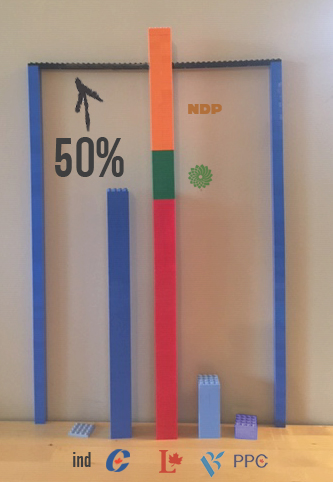 Under a proportional system, we’d also see an end to the wild distortions that paint Canada as a divided country with blue provinces and red provinces. While the seat count delivered on October 21st suggested that all Albertans voted conservative, all PEI voters are Liberals and the NDP has zero support in Quebec – the actual vote results reflect the diversity of opinions held across the country, in every province:
Under a proportional system, we’d also see an end to the wild distortions that paint Canada as a divided country with blue provinces and red provinces. While the seat count delivered on October 21st suggested that all Albertans voted conservative, all PEI voters are Liberals and the NDP has zero support in Quebec – the actual vote results reflect the diversity of opinions held across the country, in every province:
What that means, in terms of seat count, is that some parties earn way more seats than they actually deserve, while First-Past-the-Post robs other parties of seats they should have won. Regionally, this is what creates the myth of single-party domination within a province:
Of course, all these numbers are based on the votes cast under our current system. If we had a modern voting system (like most Western democracies), everything would change – not just the math on election night. We’d have more parties. Candidates would campaign differently. We’d likely have different leaders. We’d all be able to vote with our heart. And we’d end up with stable coalition governments that actually represent what voters asked for.
Is that too much to ask for?
Rivers and Meslin appear to agree. But, when the province of Ontario thought about doing this they held a referendum and the public just didn’t buy into the idea.
When the Liberals won a majority of the seats in 2015, Justin Trudeau became Prime Minister. Part of his campaign was a promise to change the way Members of the House of Commons get elected. He created a Ministry of Democratic Institutions that was going to change the way citizens determined who would represent them.
The first Minister, Maryam Monsef wasn’t able to get the job done. The Prime Minister appointed Burlington’s Karina Gould the Minister of Democratic Institutions. She claims to have done her best – saying that she could not get the needed agreement from the other political parties – the attempt to change the way we elect Members to the House of Commons was abandoned.
The mess that came out of the 2019 election created a lot of dissatisfaction and ended up with the government not having a single member from Alberta or Saskatchewan.
The Liberals will need the support of either the New Democrats or the BLOC to pass any bills. The BLOC could care less as to how the Liberals pass legislation – they have said they will support the Liberals as long as any legislation they put forward meets the interests and needs of Quebec.
The New Democrats have a much stronger social platform and will have a strong interest in the way Members are elected to the House.
Interesting days ahead.
The Meslin graphics are certainly instructive; worth paying attention to.














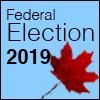


It has been shown that any possible voting system has its downside. A starting point is that there is vast room for interpreting what ‘democratic’ means, before you even try to build a voting system to implement it.
In any case, in my opinion, the ‘best’ approach is the instant run-off, where each voter votes for first, second, third, etc. This ensures that the winner has at least 50% support of the voters. It also forces all candidates to make a favorable impression and less pandering, dog whistling, and negative campaigning. Which might draw in the many voters who don’t bother.
Italy and Israel have proportional representation and they seldom end up with stable coalition governments. In fact they end up with coalitions beholden to fringe parties who then get more power than their votes merit.
No system is perfect, but our current system works better than most.
A change I would like to see is better balance to riding sizes. Why do approximately 40,000 voters in Kenora get a seat? Burlington has around 100,000 voters and we only get one seat. I get that PEI has four seats for around 120,000 voters because of the constitution. but why are Ontario ridings skewed towards rural voters?
I would also like to see mandatory voting as they have in Australia to eliminate the 9.2 million who don’t vote. That would tend to stop parties from narrow casting to get select groups to turnout and skew the electoral results.
There are may ways to improve our system.